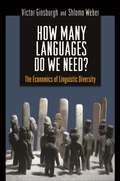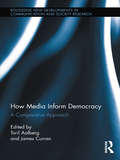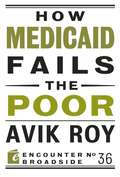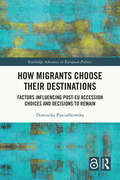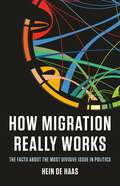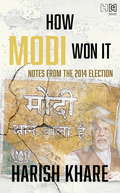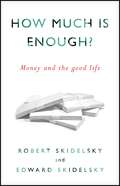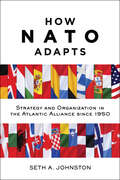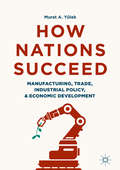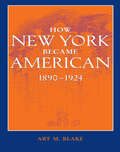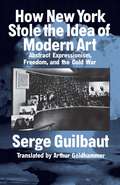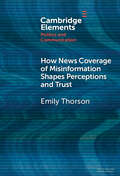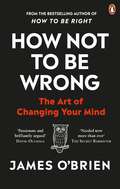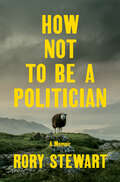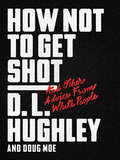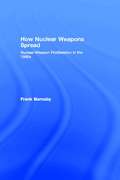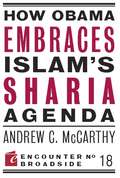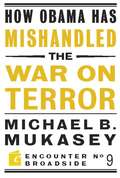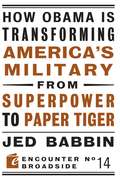- Table View
- List View
How Many Languages Do We Need?: The Economics of Linguistic Diversity
by Victor Ginsburgh Shiomo WeberIn the global economy, linguistic diversity influences economic and political development as well as public policies in positive and negative ways. It leads to financial costs, communication barriers, divisions in national unity, and, in some extreme cases, conflicts and war--but it also produces benefits related to group and individual identity. What are the specific advantages and disadvantages of linguistic diversity and how does it influence social and economic progress? This book examines linguistic diversity as a global social phenomenon and considers what degree of linguistic variety might result in the greatest economic good. Victor Ginsburgh and Shlomo Weber look at linguistic proximity between groups and between languages. They describe and use simple economic, linguistic, and statistical tools to measure diversity's impact on growth, development, trade, the quality of institutions, translation issues, voting patterns in multinational competitions, and the likelihood and intensity of civil conflicts. They address the choosing of core languages in a multilingual community, such as the European Union, and argue that although too many official languages might harm cohesiveness, efficiency, and communication, reducing their number brings about alienation and disenfranchisement of groups. Demonstrating that the value and drawbacks of linguistic diversity are universal, How Many Languages Do We Need? suggests ways for designing appropriate linguistic policies for today's multilingual world.
How Mass Atrocities End
by Bridget Conley-ZilkicGiven the brutality of mass atrocities, it is no wonder that one question dominates research and policy: what can we, who are not at risk, do to prevent such violence and hasten endings? But this question skips a more fundamental question for understanding the trajectory of violence: how do mass atrocities actually end? This volume presents an analysis of the processes, decisions, and factors that help bring about the end of mass atrocities. It includes qualitatively rich case studies from Burundi, Guatemala, Indonesia, Sudan, Bosnia, and Iraq, drawing patterns from wide-ranging data. As such, it offers a much needed correction to the popular 'salvation narrative' framing mass atrocity in terms of good and evil. The nuanced, multidisciplinary approach followed here represents not only an essential tool for scholars, but an important step forward in improving civilian protection.
How Media Inform Democracy: A Comparative Approach (Routledge New Developments in Communication and Society Research)
by James Curran Toril AalbergIn this timely book, leading researchers consider how media inform democracy in six countries – the United States, the United Kingdom, Belgium, the Netherlands, Norway, and Sweden. Taking as their starting point the idea that citizens need to be briefed adequately with a full and intelligent coverage of public affairs so that they can make responsible, informed choices rather than act out of ignorance and misinformation, contributors use a comparative approach to examine the way in which the shifting media landscape is affecting and informing the democratic process across the globe. In particular, they ask: Can a comparative approach provide us with new answers to the question of how media inform democracy? Has increased commercialization made media systems more similar and affected equally the character of news and public knowledge throughout the USA and Europe? Is soft news and misinformation predominantly related to an American exceptionalism, based on the market domination of its media and marginalized public broadcaster? This study combines a content analysis of press and television news with representative surveys in six nations. It makes an indispensable contribution to debates about media and democracy, and about changes in media systems. It is especially useful for media theory, comparative media, and political communication courses.
How Medicaid Fails the Poor
by Avik RoyMedicaid, America's government-run health insurance program for the poor, should be a lifeline that provides needed health care to Americans with no other options. Surprisingly, however, it doesn't. The medical literature reveals a $450 billion-a-year scandal: that people on Medicaid have far worse health outcomes than those with private insurance, and no better outcomes than those with no insurance at all.Why is this so? In How Medicaid Fails the Poor, Avik Roy explains how Medicaid's clumsy design and perverse incentives make it hard for people on Medicaid to get the medical care they need. Medicaid doesn't reimburse doctors or hospitals for the cost of caring for Medicaid enrollees, forcing many doctors to opt out of the program.The Affordable Care Act, otherwise known as Obamacare, doubles down on this broken system. Roy shows us that there are better ways, using private insurance, to provide needed care to our poorest citizens.
How Migrants Choose their Destinations: Factors Influencing Post-EU Accession Choices and Decisions to Remain (ISSN)
by Dominika PszczółkowskaThis book reveals how decisions regarding where to migrate are made, what factors are considered, how these change over time and why some destinations are more attractive to certain categories of people.Based on rich existent, and new data, the book explains the destination choices of Polish migrants to the four most frequently chosen destinations countries: the UK, Ireland, Germany and the Netherlands. Examined through a sophisticated theoretical framework allowing for the incorporation of factors resulting from several fields – economics, public policies, demography – and migration theories, it paints a nuanced and balanced picture of European migration.This book will be of key interest to scholars and students of migration studies, Central and Eastern European politics, and more broadly to sociology, political science, social geography and international relations.
How Migration Really Works: The Facts About the Most Divisive Issue in Politics
by Hein de HaasAn authoritative guide to global migration that corrects decades of misunderstanding and misguided policy, "defying orthodoxy on all sides of the debate" (Yascha Mounk, author of The Identity Trap). As debates on immigration have reached fever pitch, so has political and media fearmongering. But what are the facts behind the headlines? Drawing on three decades of research, migration expert Hein de Haas destroys the myths that politicians, interest groups, and media spread about immigration. He reveals: Global migration is not at an all-time high Climate change will not lead to mass migration Immigration mainly benefits the wealthy, not workers Border restrictions have paradoxically produced more migration Ultimately, de Haas shows migration not as a problem to be solved, nor as a solution to a problem, but as it really is. This book is an essential guide to one of our most divisive political issues, showing how we can move beyond today&’s deeply polarized debate and make migration work better for everyone.
How Modi Won It: Notes From The 2014 Election
by Harish KhareMarked by deep ideological divisions, a massive advertising blitz and an election campaign that could claim to rival the US presidential polls, the 2014 general election has been called `historic? for its verdict ? a political party received a majority in the Lok Sabha for the first time in three decades. In this personal, partisan and superbly perceptive narrative of how the dice rolled in the four months leading up to 16 May 2014, Harish Khare ? journalist, columnist, scholar and former media advisor to Prime Minister Manmohan Singh ? provides an honest, impassioned record of India?s greatest democratic exercise. Through a meticulous account of what he saw, heard and read during this time, Khare elucidates how the different political stakeholders kneaded into their day-to-day campaign rhetoric the latent cultural angst, economic anxieties and political expectations of a nation that has changed irrevocably over the past decade, to persuade the Indian voter to cast a decisive vote. From the brilliant and flexible campaign pitch made by the BJP to the jaded and outdated Congress rhetoric, from openly expressed middle-class aspirations to rural India?s resurgent hopes, and from communal polarization to shifting caste equations, How Modi Won It provides brilliant insight into and an incisive assessment of one of the most memorable elections in the country?s history.'
How Much Is Enough?
by K. Wayne Smith Alain C. EnthovenOriginally published in 1971, and now published with a new foreword, this is a book of enduring value and lasting relevance. The authors detail the application, history, and controversies surrounding the Planning, Programming, and Budgeting System (PPBS), used to evaluate military needs and to choose among alternatives for meeting those needs.
How Much is Enough?: Money and the Good Life
by Edward Skidelsky Robert SkidelskyWhat constitutes the good life? What is the true value of money? Why do we work such long hours merely to acquire greater wealth? These are some of the questions that many asked themselves when the financial system crashed in 2008. This book tackles such questions head-on. The authors begin with the great economist John Maynard Keynes. In 1930 Keynes predicted that, within a century, per capita income would steadily rise, people's basic needs would be met, and no one would have to work more than fifteen hours a week. Clearly, he was wrong: though income has increased as he envisioned, our wants have seemingly gone unsatisfied, and we continue to work long hours. The Skidelskys explain why Keynes was mistaken. Then, arguing from the premise that economics is a moral science, they trace the concept of the good life from Aristotle to the present and show how our lives over the last half century have strayed from that ideal. Finally, they issue a call to think anew about what really matters in our lives and how to attain it. How Much Is Enough? is that rarity, a work of deep intelligence and ethical commitment accessible to all readers. It will be lauded, debated, cited, and criticized. It will not be ignored.
How Mumbo-Jumbo Conquered the World: A Short History of Modern Delusions
by Francis WheenIn 1979 two events occurred that would shape the next twenty-five years. In America and Britain, an era of weary consensus was displaced by the arrival of a political marriage of fiery idealists: Ronald Reagan and Margaret Thatcher transformed politics with a combination of breezy charm and assertive "Victorian values." In Iran, the fundamentalist cleric Ayatollah Ruhollah Khomeini set out to restore a regime that had last existed almost 1,300 years ago. Between them they succeeded in bringing the twentieth century to a premature close. By 1989, Francis Fukuyama was declaring that we had now reached the End of History. What colonized the space recently vacated by notions of history, progress and reason? Cults, quackery, gurus, irrational panics, moral confusion and an epidemic of idiocy, the proof of which was to be found in every state, every work-place, and every library. In Idiot Proof, columnist Francis Wheen brilliantly evokes the key personalities of the post-political era-including Princess Diana and Deepak Chopra, Osama bin Laden and Nancy Reagan's astrologer-while lamenting the extraordinary rise in superstition, relativism and emotional hysteria over the past quarter of a century. In turn comic, indignant, outraged and just plain baffled by the idiocy of it all, Idiot Proof is a masterful depiction of the daftness of our times and a plea that we might just think a little more and believe a little less.
How NATO Adapts: Strategy and Organization in the Atlantic Alliance since 1950 (The Johns Hopkins University Studies in Historical and Political Science #132)
by Seth A. JohnstonDespite momentous change, NATO remains a crucial safeguard of security and peace.Today’s North Atlantic Treaty Organization, with nearly thirty members and a global reach, differs strikingly from the alliance of twelve created in 1949 to "keep the Americans in, the Russians out, and the Germans down." These differences are not simply the result of the Cold War’s end, 9/11, or recent twenty-first-century developments but represent a more general pattern of adaptability first seen in the incorporation of Germany as a full member of the alliance in the early 1950s. Unlike other enduring post–World War II institutions that continue to reflect the international politics of their founding era, NATO stands out for the boldness and frequency of its transformations over the past seventy years.In this compelling book, Seth A. Johnston presents readers with a detailed examination of how NATO adapts. Nearly every aspect of NATO—including its missions, functional scope, size, and membership—is profoundly different than at the organization’s founding. Using a theoretical framework of "critical junctures" to explain changes in NATO’s organization and strategy throughout its history, Johnston argues that the alliance’s own bureaucratic actors played important and often overlooked roles in these adaptations. Touching on renewed confrontation between Russia and the West, which has reignited the debate about NATO’s relevance, as well as a quarter century of post–Cold War rapprochement and more than a decade of expeditionary effort in Afghanistan, How NATO Adapts explores how crises from Ukraine to Syria have again made NATO’s capacity for adaptation a defining aspect of European and international security. Students, scholars, and policy practitioners will find this a useful resource for understanding NATO, transatlantic relations, and security in Europe and North America, as well as theories about change in international institutions.
How Nations Succeed: Manufacturing, Trade, Industrial Policy, and Economic Development
by Murat A. YülekThis book assesses developmental experience in different countries as well as British expansion following the industrial revolution from a developmental perspective. It explains why some nations are rich and others are poor, and discusses how manufacturing made economies flourish and spur economic development. It explains how today’s governments can design and implement industrial policy, and how they can determine economically strategic sectors to break out of Low and Middle Income Traps.Closely linked to global trade and (im)balances, industrialization was never an accident. Industrialization explains how some countries experience export-led growth and others import-led slowdowns. Many confuse industrialization with the construction of factory buildings rather than a capacity and skill building process through certain stages. Industrial policy helps countries advance through those stages. Explaining technical concepts in understandable terms, the book discusses the capacity and limits of the developmental state in industrialization and in general in economic development, demonstrating how picking-the-winner type focused industrial policy has worked in different countries. It also discusses how industrial policy and science, technology and innovation policies should be sequenced for best results.
How Negotiations End: Negotiating Behavior in the Endgame
by I. William ZartmanWhilst past studies have examined when and how negotiations begin, and how wars end, this is the first full-length work to analyze the closing phase of negotiations. It identifies endgame as a definable phase in negotiation, with specific characteristics, as the parties involved sense that the end is in sight and decide whether or not they want to reach it. The authors further classify different types of negotiator behavior characteristic of this phase, drawing out various components, including mediation, conflict management vs resolution, turning points, uncertainty, home relations, amongst others. A number of specific cases are examined to illustrate this analysis, including Colombian negotiations with the FARC, Greece and the EU, Iran nuclear proliferation, French friendship treaties with Germany and Algeria, Chinese business negotiations, and trade negotiations in Asia. This pioneering work will appeal to scholars and advanced students of negotiation in international relations, international organisation, and business studies.
How New York Became American, 1890–1924
by Art M. BlakeOriginally published in 2006. For many Americans at the turn of the twentieth century and into the 1920s, the city of New York conjured dark images of crime, poverty, and the desperation of crowded immigrants. In How New York Became American, 1890–1924, Art M. Blake explores how advertising professionals and savvy business leaders "reinvented" the city, creating a brand image of New York that capitalized on the trend toward pleasure travel. Blake examines the ways in which these early boosters built on the attention drawn to the city and its exotic populations to craft an image of New York City as America writ urban—a place where the arts flourished, diverse peoples lived together boisterously but peacefully, and where one could enjoy a visit. Drawing on a wide range of textual and visual primary sources, Blake guides the reader through New York's many civic identities, from the first generation of New York skyscrapers and their role in "Americanizing" the city to the promotion of Midtown as the city's definitive public face. His study ranges from the late 1890s into the early twentieth century, when the United States suddenly emerged as an imperial power, and the nation's industry, commerce, and culture stood poised to challenge Europe's global dominance. New York, the nation's largest city, became the de facto capital of American culture. Social reformers and tourism boosters, keen to see America's cities rival those of France or Britain, jockeyed for financial and popular support. Blake weaves a compelling story of a city's struggle for metropolitan and national status and its place in the national imagination.
How New York Stole the Idea of Modern Art: Abstract Expressionism, Freedom, And The Cold War
by Serge Guilbaut"A provocative interpretation of the political and cultural history of the early cold war years. . . . By insisting that art, even art of the avant-garde, is part of the general culture, not autonomous or above it, he forces us to think differently not only about art and art history but about society itself."—New York Times Book Review
How News Coverage of Misinformation Shapes Perceptions and Trust (Elements in Politics and Communication)
by Emily ThorsonThis Element takes on two related questions: How do the media cover the issue of misinformation, and how does exposure to this coverage affect public perceptions, including trust? A content analysis shows that most media coverage explicitly blames social media for the problem, and two experiments find that while exposure to news coverage of misinformation makes people less trusting of news on social media, it increases trust in print news. This counterintuitive effect occurs because exposure to news about misinformation increases the perceived value of traditional journalistic norms. Finally, exposure to misinformation coverage has no measurable effect on political trust or internal efficacy, and political interest is a strong predictor of interest in news coverage of misinformation across partisan lines. These results suggest that many Americans see legacy media as a bulwark against changes that threaten to distort the information environment.
How Not To Be Wrong: The Art of Changing Your Mind
by James O'Brien'Simply Brilliant' THE SECRET BARRISTER'Passionate and brilliantly argued' DAVID OLUSOGA'An admirably personal guide' MARINA HYDE'Smart, analytical, self-aware and important' ALASTAIR CAMPBELLTHE INTIMATE, REVEALING NEW BOOK FROM THE AUTHOR OF THE BESTSELLING, PRIZE-WINNING HOW TO BE RIGHT There's no point having a mind if you're not willing to change it James O'Brien has built well over a million loyal listeners to his radio show by dissecting the opinions of callers live on air, every day. But winning the argument doesn't necessarily mean you're right. In this deeply personal book, James turns the mirror on himself to reveal what he has changed his mind about and why, and explores how examining and changing our own views is our new civic duty in a world of outrage, disagreement and echo chambers. He writes candidly about the stiff upper lip attitudes and toxic masculinity that coloured his childhood, and the therapy and personal growth that have led him question his assumptions and explore new perspectives. Laying open his personal views on everything from racial prejudice to emotional vulnerability, from fat-shaming to tattoos, he then delves into the real reasons -- often irrational or unconscious -- he holds them. Unflinchingly honest, revealing and funny, How Not to Be Wrong is a tonic for a world more divided than ever and a personal manifesto for a better way of thinking and living. Because after all, if we can't change our own minds we'll never really be able to change anyone else's.
How Not to Be a Politician: A Memoir
by Rory Stewart&“[Rory Stewart] walked across Asia, served in British Parliament, and ran against Boris Johnson. Now he gives us his view of what&’s wrong with politics, and how we can make it right.&” —Adam Grant, &“The 12 New Fall Books to Enrich Your Thinking&”From a great writer—legendary for his expeditions into some of the world&’s most forbidding places—a wise, honest, and sometimes absurdist memoir of a most remarkable journey through British politics at the breaking pointRory Stewart was an unlikely politician. He was best known for his two-year walk across Asia—in which he crossed Afghanistan, essentially solo, in the months after 9/11—and for his service, as a diplomat in Iraq, and Afghanistan. But in 2009, he abandoned his chair at Harvard University to stand for a seat in Parliament, representing the communities and farms of the Lake District and the Scottish border—one of the most isolated and beautiful districts in England. He ran as a Conservative, though he had no prior connection to the politics and there was much about the party that he disagreed with.How Not to Be a Politician is a candid and penetrating examination of life on the ground as a politician in an age of shallow populism, when every hard problem has a solution that&’s simple, appealing, and wrong. While undauntedly optimistic about what a public servant can accomplish in the lives of his constituents, the book is also a pitiless insider&’s exposé of the game of politics at the highest level, often shocking in its displays of rampant cynicism, ignorance, glibness, and sheer incompetence. Stewart witnesses Britain&’s vote to leave the European Union and its descent into political civil war, compounded by the bad faith of his party&’s leaders—David Cameron, Boris Johnson, and Liz Truss.Finally, after nine years of service and six ministerial roles, and shocked by his party&’s lurch to the populist right, Stewart ran for prime minister. Stewart&’s campaign took him into the lead in the opinion polls, head-to-head against Boris Johnson. How Not to Be a Politician is his effort to make sense of it all, including what has happened to politics in Britain and the world and how we can fix it. The view into democracy&’s dark heart is troubling, but at every turn Stewart also finds allies and ways to make a difference. A bracing, invigorating mix of irony and love infuses How Not to Be a Politician. This is one of the most revealing memoirs written by a politician in living memory.
How Not to Get Shot: And Other Advice From White People
by Doug Moe D. L. HughleyNEW YORK TIMES BESTSELLER • A GOODREADS CHOICE AWARDS FINALIST"Hilarious yet soul-shaking." —Black EnterpriseThe fearless comedy legend—one of the “Original Kings of Comedy”—hilariously breaks down the wisdom of white people, advice that has been killing black folks in America for four hundred years and counting.200 years ago, white people told black folks, “‘I suggest you pick the cotton if you don’t like getting whipped.” Today, it’s “comply with police orders if you don’t want to get shot.” Now comedian/activist D. L. Hughley–one the Original Kings of Comedy–confronts and remixes white people’s “advice” in this “hilarious examination of the current state of race relations in the United States” (Publishers Weekly).In America, a black man is three times more likely to be killed in encounters with police than a white guy. If only he hadcomplied with the cop, he might be alive today, pundits say in the aftermath of the latest shooting of an unarmed black man. Or, Maybe he shouldn’t have worn that hoodie … or, moved moreslowly … not been out so late … Wait, why are black peopleallowed to drive, anyway? This isn’t a new phenomenon. White people have been giving “advice” to black folks for as long as anyone can remember, telling them how to pick cotton, where to sit on a bus, what neighborhood to live in, when they can vote, and how to wear our pants. Despite centuries of whites’ advice, it seems black people still aren’t listening, and the results are tragic.Now, at last, activist, comedian, and New York Times bestselling author D. L. Hughley offers How Notto Get Shot, an illustrated how-to guide for black people, full of insight from white people, translated by one of the funniest black dudes on the planet. In these pages you will learn how to act, dress, speak, walk, and drive in the safest manner possible. You also will finally understand the white mind. It is a book that can save lives. Or at least laugh through the pain.Black people: Are you ready to not get shot! White people: Do you want to learn how to help the cause? Let’s go!
How Nuclear Weapons Spread: Nuclear-Weapon Proliferation in the 1990s
by Frank BarnabyIn How Nuclear Weapons Spread, Frank Barnaby examines the far-reaching effects - both beneficial and detrimental - of nuclear weapons. He looks in detail at the nuclear programmes of Third World countries, including India, Israel and Pakistan which have or could very rapidly acquire nuclear weapons, and assesses the nuclear capabilities of countries such as Iran, Iraq and North Korea. He also considers the alarming possibility that terrorists might obtain nuclear weapons, and considers methods of controlling their spread.
How Obama Embraces Islam's Sharia Agenda
by Andrew C MccarthyWhile Americans focus on terrorism, a more insidious Islamist threat to our way of life lurks. It is the agenda of sharia, Islam's authoritarian legal and political system. The global Islamist movement aims, in the words of the international Muslim Brotherhood, to destroy the West by sabotaging it from within. Its principal strategy is not mass-murder but the exploitation of Western freedoms and the insinuation of sharia principles into Western legal systems. Because those principles are hostile to our core liberties - indeed, hostile even to the bedrock premise that people are free to govern themselves as they see fit - sharia's advance gradually undermines our culture.The sharia agenda has found a friend in the Obama administration, which has embraced its vanguard, including the Brotherhood and the Organization of the Islamic Conference. President Obama is actively abetting the Islamist platform: promoting sharia in his foreign policy, easing enforcement of laws that stop Islamic "charities" from diverting funds to jihadist terror, and even sponsoring a United Nations resolution that - under the guise of insulating Islam from criticism - would stifle First Amendment rights.
How Obama Has Mishandled the War on Terror
by Michael Bernard MukaseyIN this illuminating Broadside, former Attorney General Michael B. Mukasey shows how Barrack Obama has taken the war on terror from the adult realities of George W. Bush, where hard choices were faced and made, and the nation kept safe, to an adolescent fantasy world where we can at once be nobler than the law requires and safer than we were before. Obama rejects as an unnecessary sacrifice of our ideals the stern measures adopted by his predecessor, and offers instead to limit our intelligence gathering and provide terrorists with better conditions than common criminals, in the name of lofty idealism. Instead of protecting Americans, he builds castles in the air and invites us to stay safe by living in them.
How Obama is Transforming America Through Immigration
by Mark KrikorianPresident Obama and his allies have made no secret about their immigration goals: easy amnesty, loose enforcement, and ever-higher levels of legal immigration. One prominent labor leader has boasted that continued mass immigration "will solidify and expand the progressive coalition for the future."In this penetrating Broadside, Mark Krikorian lays out the details of Obama's open-borders approach to immigration and its political consequences. Krikorian, one of the leading critics of current immigration policy, examines the Administration's record of weakening enforcement and describes how legislation crafted by the president's supporters in Congress would ensure new waves of illegal immigration. Krikorian also explains how continued high levels of immigration, regardless of legal status, would progressively move the United States in the direction of more government and less liberty.
How Obama is Transforming America's Military from Superpower to Paper Tiger
by Jed BabbinBarack Obama has made it clear that he thinks the world would be a better and more peaceful place if the United States were too weak to affect the course of events. Obama, along with Secretary of Defense Robert Gates, has slashed missile defense, dramatically reduced investment in future military technologies, and broken promises to our allies. In addition, Obama is transforming our military into a politically correct force that no one will want to join.In this incisive Broadside, Jed Babbin analyzes Obama's military strategy and shows how he has pursued a consistent course of action that defines him and his overriding objective - to reduce America from a superpower to a paper tiger. These are not the policies of a president who wants America to be strong, safe, and secure. But they are the policies that define Barack Obama.ENCOUNTER BROADSIDES: a new series of critical pamphlets from Encounter Books. Uniting an 18th-century sense of political urgency and rhetorical wit (think The Federalist Papers, Common Sense) with 21st-century technology and channels of distribution, Encounter Broadsides offer indispensable ammunition for intelligent debate on the critical issues of our time. Written with passion by some of our most authoritative authors, Encounter Broadsides make the case for liberty and the institutions of democratic capitalism at a time when they are under siege from the resurgence of collectivist sentiment. Read them in a sitting and come away knowing the best we can hope for and the worst we must fear.
How Obama's Gender Policies Undermine America
by Diana Furchtgott-RothWomen are riding out the recession more easily than men, with a lower unemployment rate and a higher percentage attaining high school diplomas and Bachelor and Master degrees. Yet President Obama and Congress, responding to fierce feminist lobbying, propose to expand preferences for women in both education and hiring. Whereas original feminists portrayed women as equal to men, the 21st century feminist message is that women cannot succeed without affirmative action. Not only does this harm men by reducing their opportunities, but it hurts women by invalidating any legitimate credentials gained without the benefit of gender preferences.The great irony is that women succeed in everyday America, but are doomed to failure in the distorted lens of radical feminists. A woman who chooses a job with a flexible schedule in order to have time both for her family and her career thinks of herself as successful. But to feminists, she is a failure because she has chosen a lower earnings path rather than the CEO track.
